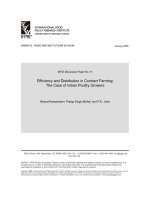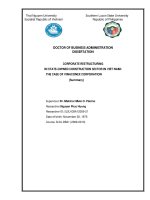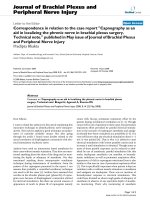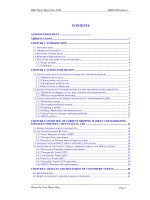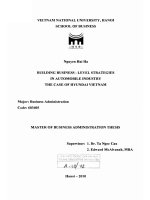Development of domestic suppliers of electronics in viet nam the case sudy of canon viet nams strategy
Bạn đang xem bản rút gọn của tài liệu. Xem và tải ngay bản đầy đủ của tài liệu tại đây (2.59 MB, 307 trang )
DEVELOPMENT OF DOMESTIC SUPPLIERS OF ELECTRONICS IN
VIETNAM: THE CASE STUDY OF CANON VIETNAM’S STRATEGY
___________________________
A DISSERTATION
Presented to the Faculty of the Graduate School
Southern Luzon State University, Lucban, Quezon, Philippines
in Collaboration with
Thai Nguyen University, Socialist Republic of Vietnam
___________________________
In Partial Fulfillment
of the Requirements for the Degree
Doctor of Business Administration
___________________________
By
TRAN XUAN NGOC (RONALDO)
December 2013
i
APPROVAL SHEET
The Dissertation of
TRAN XUAN NGOC
entitled
DEVELOPMENT OF DOMESTIC SUPPLIERS OF ELECTRONICS IN
VIETNAM: THE CASE STUDY OF CANON VIETNAM’S STRATEGY
Submitted in Partial Fulfilment of the Requirements for the Degree
DOCTOR OF BUSINESS ADMINISTRATION
A program offered by Southern Luzon State University,
Republic of the Philippines in collaboration with
Thai Nguyen University, Socialist Republic of Vietnam
has been approved by Oral Examination Committee
MELCHOR MELO O. PLACINO, PhD
Expert
EDWIN P. BERNAL, DBA
Expert
WALBERTO A. MACARAAN, EdD
Expert
ALICE T. VALERIO, PhD
External Panel
CECILIA N. GASCON, PhD
Chairman
Endorsed by:
Recommended by:
EDUARDO T. BAGTANG, DBM
Adviser
APOLONIA A. ESPINOSA, PhD
Dean
Accepted in Partial Fulfilment of the Requirements for the Degree
Doctor of Business Administration
_____________________
Date
WALBERTO A. MACARAAN, EdD
Vice President for Academic Affairs
ii
CERTIFICATE OF ORIGINALITY
iii
ACKNOWLEDGMENT
Firstly, I am particularly grateful to my dissertation committee: Dr.
Cecilia N. Gascon, Dr. Walberto A. Macaraan, Dr. Edwin P. Bernal, Dr. Milo
O. Placino, Dr. Alice T. Valerio, and special thanks to my adviser, Dr. Eduardo
T. Bagtang, It is only with their precious assistance, support and guidance that
I was able to fulfill my dissertation. They shared valuable time from their busy
schedules to help and give me critical comments and suggestions.
I gratefully acknowledge Southern Luzon State University, Thai Nguyen
University, Thai Nguyen University of Agriculture and Forestry, International
School - Thai Nguyen University, International Training Center of Thai Nguyen
University of Agriculture and Forestry, and the staff. I have greatly benefited
from good study facilities, materials, and dynamic academic environment.
I want to express my deep gratitude to Hanoi People's committee,
Hanoi Vocational College of High Technology who supported my studies.
I am greatly indebted to the researchers and all my colleagues who
have helped me to overcome many difficulties and for sharing their views and
insights on this dissertation as well.
Finally, I wish to thank my family members for their spiritual
encouragement and material support. My gratitude also goes to all those who
may not have participated directly in the accomplishment of this humble
research output but their works have been essential to the success of my
dissertation.
Tran Xuan Ngoc
iv
DEDICATION
This dissertation is dedicated to:
My great teacher, Dr. Eduardo T. Bagtang, whose support and
guidance has inspired me to be able to fulfill my dissertation,
Hanoi People's committee, Hanoi Vocational College of High
Technology, my second magnificent home with hope and support,
My great parents, who never stop giving moral support and even
sacrificed themselves in countless ways,
My dearest wife, Hanh Nguyen, my loving companion for the rest of my
life,
My beloved kids: Phuong Uyen, and Bao Chau, whom I shall love
forever,
My beloved brothers and sisters who have always stood by me when
things look bleak,
To all my family, the symbol of love and giving,
My friends and my colleagues who constantly encourage and support
me,
All the people in my life who have touched my heart,
I dedicate this research.
v
TABLE OF CONTENTS
PAGE
TITLE PAGE ………………………………………………………………..
i
APPROVAL SHEET ……………………………………………………….
ii
CERTIFICATE OF ORIGINALITY ………………………………………..
iii
ACKNOWLEDGEMENT …………………………………………………..
iv
DEDICATION ………………………………………………………………
v
TABLE OF CONTENTS …………………………………………………..
vi
LIST OF TABLES ………………………………………………………….
viii
LIST OF FIGURES ………………………………………………………...
xiii
LIST OF APPENDICES …………………………………………………...
xiv
ABSTRACT …………………………………………………………………
xv
CHAPTER
I
II
III
INTRODUCTION ……………………………………………
1
Background of the Study …………………………………..
1
Statement of the Problem ………………………………….
5
Objectives of the Study …………………………………….
5
Hypothesis of the Study ……………………………………
8
Significance of the Study …………………………………..
8
Scope and Limitations of the Study ………………………
10
Definition of Terms ………………………………………….
11
REVIEW OF LITERATURE ……………………………….
15
Conceptual Framework ………………………………….…
117
METHODOLOGY
Locale of the Study …………………………………………
118
Research Design ……………………………………………
119
Populations, Sample & Sampling Technique ……………
122
Research Instrument ……………………………………….
123
Data Treatment and Processing Method ……….…….….
124
Statistical Treatment ………………………........…….……
124
vi
IV
RESULTS AND DISCUSSIONS ………………………….
129
Extent of Profile of Canon Vietnam ……………………….
129
Extent of Autonomy of Subsidiary Company ….…………
145
Extent of Knowledge Transfer from Subsidiary
Company to Local Suppliers ………………………………
164
Case Studies of Four Canon’s Local Suppliers …………
187
Extent of Competitive Advantage of Canon Vietnam …..
200
Extent of Implementation of Government Policies ……...
218
Extent of Factors Affecting the Capacity Development
230
of Local Suppliers …………………………………………..
V
SUMMARY, CONCLUSION AND RECOMMENDATION
Summary …………….………………………………………
253
Conclusions …………………………………………………
256
Recommendations …………………………………………
258
REFERENCES ………………………...…………………………………..
271
APPENDICES ……………………………………………………………...
279
CURRICULUM VITAE …………………………………………………….
289
vii
LIST OF TABLES
TABLE
1
PAGE
The Development of the Electronics Industry and its
Supplier Industries in ASEAN Countries
4
2
Number of Local Suppliers
30
3
Profile of Local Suppliers
31
4
Transferred Knowledge Between Canon and Local
Suppliers
63
5
Localization of Canon’s Electronics
83
6
The Situation of the Electronics Industry and its Supplier
Industries in ASEAN Countries
116
7
Factor Loading
125
8
Comparison Between the Perceptions of Managers of
Canon Vietnam and Managers of Suppliers as to Profile of
the Canon Vietnam Affecting the Capacity Development of
Local Suppliers
129
Comparison Between the Perceptions of Managers of
Canon Vietnam and Managers of Suppliers on the Extent
of Profile of Canon Vietnam Affecting Domestic Electronic
Suppliers
137
Comparison Between the Perceptions of Managers of
Canon Vietnam and Staff as to Extent of Profile Affecting
the Capacity Development of Local Suppliers
138
Comparison Between the Perceptions of Managers of
Suppliers and Employees as to Extent of Profile Affecting
the Capacity Development of Local Suppliers
139
Comparison Between the Perceptions of the Canon
Vietnam Employees and Suppliers’ Employees as to
Profile of Canon Vietnam Affecting the Capacity
Development of Local Suppliers
142
Comparison Between the Perceptions of Staff of Canon
Vietnam and Employees of Suppliers on the Extent of
Profile of Canon Vietnam Affecting Domestic Electronic
Suppliers
144
9
10
11
12
13
viii
TABLE
14
15
16
17
18
19
20
21
22
23
24
PAGE
Mean Difference of the Perceptions of the Managers and
Staff of both Canon and Suppliers on the Extent of Profile
Affecting the Capacity of Domestic Suppliers
144
Comparison Between the Perceptions of Managers of
Canon & Managers of Suppliers on the Extent of
Autonomy Affecting Capacity Development of Suppliers
145
Comparison Between the Perceptions of Managers of
Canon & Managers of Suppliers on the Extent of
Autonomy Affecting Capacity Development of Suppliers
157
Comparison Between Perceptions of Canon Managers and
Staff on the Extent of Autonomy Affecting Capacity
Development of Local Suppliers
158
Comparison Between the Perceptions of the Managers of
Suppliers and their Staff on the Extent of Autonomy
Affecting Capacity Development of Local Suppliers
159
Comparison Between the Perceptions of Employees of
Canon and Suppliers on the Extent of Autonomy of Canon
Vietnam Affecting Capacity Development of Local
Suppliers
160
Comparison Between the Perceptions of Canon
Employees & Employees of Suppliers on the Extent of
Autonomy of Canon Vietnam Affecting Capacity
Development of Local Suppliers
162
Mean Difference of the Perceptions of the Managers and
Staff of both Canon and Suppliers on the Extent of
Autonomy Affecting the Capacity of Domestic Suppliers
163
Comparison Between the Perceptions of Canon Managers
and Managers of Suppliers on the Extent of Knowledge
Transfer Affecting the Capacity Development of Local
Suppliers
164
Comparison Between the Perceptions of Canon Managers
and Managers of Suppliers on the Extent of Knowledge
Transfer Affecting the Local Suppliers’ Capacity
Development
171
Comparison Between the Perceptions of Canon Managers
and Staff on the Extent of Knowledge Transfer of Canon
Vietnam Affecting the Capacity Development of Local
Suppliers
172
ix
TABLE
25
26
27
28
29
30
31
32
33
34
PAGE
Comparison Between the Perceptions of Suppliers’
Managers and Staff on the Extent of Knowledge Transfer
Affecting Local Suppliers’ Capacity Development
173
Comparison between the Perceptions of Employees of
Canon & Employees of Suppliers on the Extent of
Knowledge Transfer Affecting the Capacity Development
of Local Suppliers
175
Comparison Between the Perceptions of Canon
Employees & Employees of Suppliers on the Extent of
Knowledge Transfer Affecting Capacity Development of
Local Suppliers
181
Mean Difference of the Perceptions of the Managers and
Employees of both Canon Vietnam and Suppliers on the
Extent of Knowledge Transfer Affecting the Capacity of
Local Suppliers
182
Comparison Between the Perceptions of Canon Managers
& Managers of Suppliers on the Extent of Competitive
Advantage of Canon Vietnam Affecting the Capacity
Development of Suppliers
201
Comparison Between the Perceptions of Canon Managers
& Managers of Suppliers on the Extent of Competitive
Advantage of Canon Vietnam Affecting the Capacity
Development of Suppliers
211
Comparison Between the Perceptions of Canon Managers
and Staff on the Extent of Competitive Advantage of
Canon Vietnam Affecting the Suppliers’ Capacity
Development
213
Comparison Between the Perceptions of Managers of
Suppliers and Staff on the Extent of Competitive
Advantage of Canon Vietnam Affecting Suppliers’ Capacity
Development
214
Comparison Between the Perceptions of Canon
Employees & Employees of Suppliers on the Extent of
Competitive Advantage of Canon Vietnam
215
Comparison Between the Perceptions of Canon Staff &
Staff of Suppliers on the Extent of Competitive Advantage
of Canon Vietnam
216
x
TABLE
35
36
37
38
39
40
41
42
43
44
45
PAGE
Mean Difference of the Perceptions of the Managers and
Staff of Both Canon and Suppliers on the Extent of
Competitive Advantage Affecting the Capacity of Domestic
Suppliers
Comparison Between the Perceptions of Canon Managers
& Managers of Suppliers on the Extent of Implementation
of Government Policies Affecting Capacity Development of
Local Suppliers
216
218
Comparison Between the Perceptions of Canon Managers
& Managers of Suppliers on the Extent of Assistance of the
Government Policies
224
Comparison Between the Perceptions on the Extent of
Assistance of the Government as Perceived by Canon
Managers and Canon Staff
225
Comparison Between the Perceptions of Managers of
Suppliers and Staff on the Extent of Assistance of the
Government Affecting the Capacity Development of
Suppliers
225
Comparison Between the Perceptions of Canon
Employees & Employees of Suppliers on the Extent of
Assistance of the Government Policies
226
Comparison Between the Perceptions of Canon
Employees & Employees of Suppliers on the Extent of
Assistance of Government Policies
227
Mean Difference of the Perceptions of the Managers and
Staff of Both Canon and Suppliers on the Extent of
Government Assistance Affecting the Capacity of
Domestic Suppliers
228
Comparison Between the Perceptions of Canon and
Suppliers’ Managers on the Extent of Factors Affecting the
Capacity Development of Local Suppliers
230
Comparison Between the Perceptions of Canon and
Suppliers’ Managers on the Extent of Factors Affecting the
Capacity Development of Local Suppliers
231
Comparison Between the Perceptions of Canon Vietnam
Managers and Canon Vietnam Employees on the Extent of
the Factors Affecting the Capacity Development of Local
Suppliers
232
xi
TABLE
46
47
48
49
50
51
52
53
54
55
56
57
PAGE
Comparison of the Perceptions of Managers of Suppliers
and Employees on the Extent of the Factors Affecting the
Capacity Development of Local Suppliers
233
Comparison of the Perceptions of Canon Vietnam
Employees and Employees of Suppliers on the Extent of
the Factors Affecting the Capacity Development of Local
Suppliers
234
Comparison of the Perceptions of Canon and Suppliers
Employees on the Extent of the Factors Affecting
Capacity Development of Local Suppliers
235
Comparison of the Mean Differences of Perceptions of
Canon Managers & Suppliers and Employees of Canon &
Suppliers on the Extent of the Factors Affecting the
Capacity Development of Local Suppliers
236
Mean difference of the Perceptions of the Managers and
Employees of Both Canon and Suppliers on the Extent of
the Factors Affecting the Capacity Development of
Domestic Suppliers
237
Correlation of the Factors Affecting
Development among Local Suppliers
238
the
Capacity
Reliability of the Independent Variable: Company’s Profile CP
241
Reliability of the Independent Variable: Autonomy of
Company - AC
242
Reliability of the Independent Variable: Knowledge
Transfer –KT
243
Reliability of the Independent Variable: Competitive
Advantages - CA
243
Reliability of the Independent Variable: Government
Policies - GP
244
The reliability of the Control Variable:
Development of Local Suppliers – CDLS
245
Capability
58
Statistical Description of the Scale
246
59
Variables Entered/Removed
250
60
Model Summary
250
xii
LIST OF FIGURES
FIGURE
1
PAGE
Vietnam’s Import Value of Electronic Components,
Electronic and Computer Items
20
2
Performance Results of Canon Vietnam
28
3
Absorptive Capacity
61
4
Environment Change and Canon Response
70
5
Definition of Supporting Industries
75
6
Porter’s Diamond
90
7
“Supplier Industries” Concept of Japan
96
8
“Players” Network of the “Game Theory”
100
9
“Players” Network in Supplier Industries
101
10
Expanded “Players” Network in Supplier Industries in a
Country
101
11
Production Process of Electronic Products
104
12
Export Value of Vietnam’s Electronics Components and
Computer Units
107
Vietnam’s Import Value of Electronic Components,
Electronic and Computer Items
109
Conceptual Paradigm
117
13
14
xiii
LIST OF APPENDICES
APPENDIX
PAGE
A
Canon’s Evaluation on Supplier Capabilities ..
280
B
Characteristics of Newly Established Enterprises
281
C
CVN Organization
282
D
Questionnaire 1: For Canon Vietnam
283
E
Questionnaire 2: For Suppliers
286
`
xiv
ABSTRACT
Title of Research
: DEVELOPMENT OF DOMESTIC SUPPLIERS OF
ELECTRONICS IN VIETNAM: THE CASE STUDY
OF CANON VIETNAM’S STRATEGY
Researcher
: TRAN XUAN NGOC (RONALDO)
Degree Conferred
: DOCTOR OF BUSINESS ADMINISTRATION
Name and Address
of Institution
: Southern Luzon State University Lucban, Quezon,
Philippines and Thai Nguyen University, Socialist
Republic of Vietnam
Adviser
: Dr. Eduardo T. Bagtang
Year Written
: 2013
______________________________________________________________
The study was conducted
to determine the extent of the factors that
can help develop the capacity of local or domestic electronic suppliers in
Vietnam. Specifically, the study was focused on the extent of autonomy,
knowledge transfer strategies, comparative advantage and government
services of local suppliers.
A total of 250 respondents were identified, 6 managers of Canon
Vietnam, 4 managers of local suppliers, 100 staff members of Canon Vietnam
and 144 staff members of local suppliers
that were randomly selected.
Structured questionnaire was used in gathering data. Secondary data were
obtained from the Ministry of Industry, Ministry of Finance and Ministry of
Security to determine the profile of the companies. The SPSS program was
used in processing the data. The t-Test was used to determine the significant
differences regarding the perception of managers and staff on the factors that
affect the development capacity of local electronic suppliers while Pearson
correlation was used to determine the relationship between the variables.
xv
Cronbach’s Alpha coefficient was also used to test the reliability of the derived
model for capability building to be adapted by the local electronics suppliers.
Findings showed that both the managers and suppliers of Canon
agree that the profile of Canon Vietnam affects the development capability of
domestic suppliers with a mean of 3.59 while the employees of Canon and
suppliers were uncertain with a mean of 3.14. This finding implies that there is
a gap in the operation at the local level hence there is need for Canon
Vietnam to strengthen or expand their operation in the local areas to be able
to reach out to their clients.
On the extent of autonomy, it was found out that there was no
significant difference regarding the perceptions between the managers of
Canon, managers of suppliers, employees of Canon and employees of
suppliers.
Managers have a total average weighted mean of 4.3 while
employees have obtained 4.21 where they both agree .Likewise, it is noted
that organizational structure and research & development found out to have
the lowest mean.
As to the extent of knowledge transfer, it was found out that there is no
significant difference regarding the perceptions between the managers of
Canon, managers of suppliers, employees of Canon and employees of
suppliers.
As to the extent of comparative advantage, it was found out that there
is no significant difference of the perceptions between the managers of
Canon, managers of suppliers, employees of Canon and employees of
suppliers.
xvi
With respect to the extent of government policies and assistance, it
was found out that there is no significant difference regarding the perceptions
between the managers of Canon, managers of suppliers, employees of
Canon and employees of suppliers.
As regards the extent of influence of the factors on the capacity
development of local suppliers, it was found out that there is no significant
difference of the perceptions between the managers of Canon, managers of
suppliers, employees of Canon and employees of suppliers. Hence, profile,
autonomy, knowledge transfer, comparative advantage and government
policies had affected the capacity development of local suppliers.
The results of correlation coefficient was highly significant among
competitive advantage ,autonomy, knowledge transfer, government policies
and company profile indicating that
all the factors included in the study
influenced capacity development of local suppliers; hence, model 4 of the
Canon Vietnam strategy shall be adopted by other suppliers.
Finally, this study found out that there were identified gaps on profile
such as organizational structure and company culture ; autonomy research &
development and financial management ; knowledge transfer
impacting
responsiveness and absorptive capacity; competitive advantage affecting
production capacity and product design ; and government policies focusing
more on the enhancement of the Central Management Unit ; hence, all the
identified gaps are recommended for capacity enhancement among the local
suppliers of Canon Vietnam.
xvii
1
Chapter I
INTRODUCTION
After 25 years of reform, Vietnam's economy has grown stronger and
since then has been steadily being integrated deeper into regional as well as
global economies. Likewise, a number of industries have experienced fast
growth like the first Vietnam businesses that have been involved in the global
supply chain Vietnam is now an emerging market that is very attractive to
international investors ,multinational stakeholders and economic researchers.
Experience has proven that the emerging markets could bring
businesses the most important investment opportunities and growth. The
emerging markets are the places to test the concept, model, and existing
theories of business growth and progress. At the same time, these very
markets also create opportunities for research and the development of new
theories in the field of business administration.
The topic "Developing Domestic Suppliers of Electronics in Vietnam:
The Case of Canon Vietnam’s Strategy” is indeed vital, meaningful and useful
for managers of multinational companies in the electronic field in terms of
attracting investors that are now operating in Vietnam. The owners of the
firms who are currently providing electronic domestic products are now
Vietnam’s policymakers.
Background of the Study
Amongst the emerging markets, Vietnam is a very classic example of
the great and profound changes in attracting foreign investments to a
2
developing domestic industry. However, the industrialization of Vietnam today
faces huge challenges.
It must survive under the conditions of trading
liberalization with other countries all over the world. The competitiveness of
the Vietnamese industrial products in general is weak, especially those in
manufacturing machinery, equipment, components and materials. It seems
that the most basic weakness of Vietnam's industry stems from the weakness
of supporting industries. This involves the "survival" of Vietnam industries,
which is closely associated with whether the economy of Vietnam can be
internationally competitive enough to develop. On the other hand, the
weaknesses of the fundamental facility have contributed to the deficit of the
trading balance in Vietnam because the country itself has to import a lot of
components and raw materials for export production which therefore can
invariably cost more if it aims to improve the export capacity of the products.
As a result, if Vietnam boosts exports, the faster the demand for inputs
increases, the sooner it will lead to trade deficit which eventually might be
harder for the country to take.
Currently, the development of the domestic market is fraught with
spontaneity and lacks sustainability. Even though micro to small businesses
are common in Vietnam, they are not developed enough for international
export purposes. For those businesses which suit the international export
market which are few, as the majority belongs to small and medium
businesses, those of which are uneducated due to the poor condition of
fundamental and technical facilities and which lack developmental strategies,
capacity are in fact the ones which are in a weak position to deal with the
international market on the whole. The implementation of regional and
3
international commitments regarding Vietnam is still passive at this time. The
major businesses are still expecting an extension of protectorate to remain
afloat. The slow application of international standards in production and trade
has caused some businesses in Vietnam difficulties when joining the
production cycle within the local market.
Within the manufacturing industry, electronics is highly representative
of a developing country with a large population like that of Vietnam. In the
context of scientific and technological progress and globalization today, the
present status of the electronics industry in Vietnam has revealed a number of
problems. On the domestic scene, the supply businesses in Vietnam are in a
much weaker position than firms with foreign capital investment. On the other
hand, the electronic products of Vietnam are put under a huge competitive
pressure from China. In terms of the value chain, the electronics industry in
Vietnam mainly assembles consumer products, focusing on the stages with
minimal value attached. Very few companies produce detailed parts and
accessories in electronics. Foreign investors in this sector are mainly exportoriented, not oriented to promote connectivity supporting industries within the
country to create a shift in the value chain. This limits the ability to develop
this sector and likewise limits the impact of technological transfers as well as
the scalability to attract FDI. The assembling phase is mainly focused toward
cheap labor, but this is not an advantage to maintain the long-term economic
health of the country.
4
Table 1
The Development of the Electronics Industry and its Supplier Industries in ASEAN Countries
Country
Starting time
Key Products
Scale
Thailand
1960s
Computer and Accessories
Audio-Visual Products
Refrigeration
Office Equipment
620 companies with 521
FDIs 300.000 labor
Malaysia
In the middle of
1960s
Singapore
1960s
Consumer Electronics
Premium Accessories
Audio-Visual Accessories
Specialized Electronics
Telecommunications
Computer
Hi-Tech Accessories
900 companies
Two thirds FDIs, especially
Japanese
250 companies
150.000 labor
Philippines
Early 1970s
Specialized Electronics
Consumer Electronics
Computer Accessories
Terminals
Semi-Conductors
590 companies
72% FDIs- 30% Japanese
350.000 labor
Indonesia
Early 1970s
100 companies
Two thirds FDIs with
majority of Japanese
Major Export Markets
- Turnover in 2001: US$23
billion
- ASEAN: 22%,
The US: 20%
EU 17%
Japan 16%
- Turnover in 2001: US$70
billion
60% for export
Japan 36%
The US 34%, ASEAN and Asia:
31%
Turnover in 2003: US$10 billion
95% for export
Turnover in 2003: 9 US$billion
95% for export
Source: Compiled from reports by the Ministry of Industry and Commerce, Vietnam Electronic Industries Association, Viettronics
5
Statement of the Problem
The recent state of the electronics industry in Vietnam has revealed
problems of competition regarding local suppliers compared to foreign
suppliers. Local suppliers in Vietnam are in a much weaker position when
compared to foreign suppliers.
Foreign investors import the majority of the components in electronic
products; hence, the local suppliers can no longer compete with them despite
having cheaper labor costs to produce these components.
This situation
limits the development of the Electronic Industry in Vietnam.
To assist the local suppliers in Vietnam to remain competitive there is a
fundamental need to develop their capabilities. Hence this study is primarily
aimed to determine the gaps for capacity development amongst the local
electronics suppliers through the Canon Vietnam Strategy.
Specifically, the study will seek to find out the following issues of
concern:
1. What is the extent of critical factors that affect the capacity
development regarding local suppliers?
2. What are the factors associated with the capacity development
concerning local suppliers?
Objectives of the Study
The overall objective of the study is to determine the factors that can
help develop the capabilities of local or domestic suppliers in Vietnam.
Specifically, the study aims to determine the current operation of Canon
Vietnam’s following objectives:
6
1. To determine the profile of Canon Vietnam as perceived by Managers
of Canon Vietnam, Managers of Suppliers and their Employees in
terms of the following:
1.1. Company Culture
1.2. Organizational Structure
1.3. Operation Scale
1.4. Local Operational Duration
1.5. Number of Local Suppliers
2. To determine the extent of autonomy of Canon Vietnam as perceived
by Managers of Canon Vietnam, Managers of Suppliers and their
Employees in terms of the following:
2.1. R&D
2.2. Financial Management
2.3. Marketing Strategy
2.4. Production Strategy
2.5. Production Process
2.6. Supplier Selection
3. To determine the extent of the knowledge transfer from subsidiary
companies to local suppliers as perceived by Managers of Canon
Vietnam, Managers of Suppliers and their Employees in terms of:
3.1. Absorptive Capacity
3.2. Responsiveness
3.3. "Hands-on" Approach in Skills Development Knowledge Transfer
7
4. To determine the extent of the competitive advantages of the Canon
subsidiaries that can help develop local suppliers as perceived by
Managers of Canon Vietnam, Managers of Suppliers and their
Employees.
4.1. Production Capacity
4.2. Capacity of Design and New Developments
4.3. Production Technology
4.4. Qualifications of the Management
4.5. Price Policy
5. To determine the extent of Government policies towards the
development of the local suppliers’ capabilities as perceived by
Managers of Canon Vietnam, Managers of Suppliers and their
Employees.
5.1. Protection of Domestic Production (import tax…)
5.2. Priority for the Electronics Industry (incentives, production tax…)
5.3. Central Management Unit
5.4. Setting Up of Standards regarding Quality and Components
5.5. Reducing the Gap between Policies and Implementation
6. To determine the extent of the factors that affect capacity development
of local suppliers as perceived by Managers of Canon Vietnam,
Managers of Suppliers and their Employees
7. To determine the degree relationship of the profile, autonomy,
knowledge transfer, competitive advantage, government policies and
capacity development.
8
Hypotheses of the Study
This study aims is to test the following hypotheses:
H1. There is no significant difference in the perceptions of the
managers of Canon Vietnam, Managers of Local Suppliers, Employees of
Canon Vietnam and Employees of Local Suppliers along
a. Company profile
b. Autonomy
c. Knowledge Transfer
d. Competitive Advantage
e. Government Policies
H2. There is no significant relationship between capacity buildings of
local electronics suppliers with regard to the following factors:
a. Company Profile
b. Autonomy
c. Knowledge Transfer
d. Competitive Advantage
e. Government Policies
Significance of the Study
The results of this study will help local suppliers determine the needs of
multinational companies, adjust their operation strategies, improve capacity
and strengthen their competitiveness.
Likewise, in consideration of how the strategies of Canon will be
implemented, the results are vital for practical purposes in order that the
business sector will be able to provide insights on how subsidiary companies

